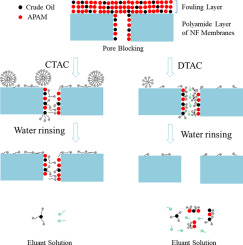Science of the Total Environment ( IF 8.2 ) Pub Date : 2018-10-17 , DOI: 10.1016/j.scitotenv.2018.10.221 Dongsheng Zhao , Liping Qiu , Jiyu Song , Junxia Liu , Zonghua Wang , Youbing Zhu , Guicai Liu

|
A spiral-wound nanofiltration (NF) membrane module harvested from a full-scale produced wastewater desalination plant was examined and cleaned to explore appropriate chemical cleaning protocols. Foulant identification and cleaning efficiency and mechanisms were investigated. For total foulants, the organic components, including anionic polyacrylamide (APAM) and crude oil, accounted for a weight percentage of 86.3%, while the remaining foulants constituted the inorganic fraction, including Na, Mg, Ca, Ba, Al, Fe and Si. Short-term cleaning experiments were designed to identify effective reagents that could be used for further evaluations of their cleaning efficiencies in long-term cleaning. For citric acid and ethylenediaminetetraacetic acid tetrasodium (EDTA-4Na), the long-term cleaning efficiencies were relatively slight or even negative, while said values varied with different surfactants. Dodecyltrimethylammonium chloride (DTAC) achieved the greatest flux recovery; conversely, cetyltrimethylammonium chloride (CTAC) provided insignificant, even negative effects, on flux recovery, as well as salt rejection, of the fouled NF membranes. FTIR and zeta potential analyses of the fouled membranes indicated that all the tested surfactants were identically effective in removing the foulants from the membrane surface, but their cleaning efficiencies differed. Moreover, a strong correlation between the flux ratio (Sf) and concentration of surfactant in the permeate (Cps) was observed. Among the tested chemical reagents, DTAC yielded the highest Cps and the greatest flux recovery, with an Sf of 2.25. Considering this correlation and the characteristics of the fouled membranes and surfactants, it is proposed that DTAC molecules penetrated the membrane pores and removed the foulants that were attached to the pore walls.
中文翻译:

用于生产废水脱盐的纳滤膜化学清洗剂的效率和机理
检查并清洗了从大规模生产的污水淡化厂收获的螺旋缠绕式纳滤(NF)膜组件,以探索适当的化学清洗方案。研究了污垢的识别,清洁效率和机理。对于总污垢,包括阴离子聚丙烯酰胺(APAM)和原油在内的有机成分占86.3%的重量百分比,而其余污垢构成无机部分,包括Na,Mg,Ca,Ba,Al,Fe和Si 。短期清洁实验旨在确定有效的试剂,这些试剂可用于进一步评估其在长期清洁中的清洁效率。对于柠檬酸和乙二胺四乙酸四钠(EDTA-4Na),长期清洁效率相对较低,甚至为负,而所述值随表面活性剂的不同而变化。十二烷基三甲基氯化铵(DTAC)的通量回收率最高;相反,鲸蜡基三甲基氯化铵(CTAC)对污染的NF膜的通量回收率和除盐率影响不大,甚至产生负面影响。污垢膜的FTIR和Zeta电势分析表明,所有测试的表面活性剂在去除膜表面污垢方面均具有相同的效果,但是它们的清洁效率不同。而且,通量比(S 被污染的NF膜。污垢膜的FTIR和Zeta电势分析表明,所有测试的表面活性剂在去除膜表面污垢方面均具有相同的效果,但是它们的清洁效率不同。而且,通量比(S 被污染的NF膜。污垢膜的FTIR和Zeta电势分析表明,所有测试的表面活性剂在去除膜表面污垢方面均具有相同的效果,但是它们的清洁效率不同。而且,通量比(Sf)和渗透物中的表面活性剂浓度(C ps)。在测试的化学试剂中,DTAC产生最高的C ps和最大的通量回收率,S f为2.25。考虑到这种相关性以及污垢的膜和表面活性剂的特性,建议DTAC分子穿透膜孔并去除附着在孔壁上的污垢。











































 京公网安备 11010802027423号
京公网安备 11010802027423号